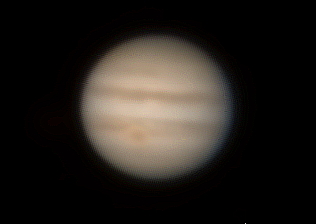
Jupiter and Great Red Spot, Lunar Crater Pythagoras
Posted: 13 April 2014
|
Opened: Saturday, 12 April 2014, 1945 MST Temperature: 69°F |
Session: 672 Conditions: Clouds moving off to southeast; breezy |
1952 MST: viewed waxing gibbous moon, 83X. Added Variable Polarizing Filter to reduce brightness for easier viewing. Removed the filter and did some handheld iPhone 5s afocal imaging at 83X. This was taken at 1959 MST:

2000 MST: did some lunar observing, 222X. Seeing was not very good. Tried some handheld iPhone 5s afocal imaging at 222X of the crater Pythagoras, but seeing wasn't very good so images were not very good either.
2012 MST: slewed to Jupiter and did some observing, 222X. Three moons and the Great Red Spot were visible. Then did some iPhone 5s slo-mo video recordings of Jupiter, 666X, using my homemade afocal adapter and the earbuds volume control as a remote shutter release. This is a stack of 1130 frames taken at 2019 MST:

2023 MST: viewed Mars, still somewhat low in the southeast, 666X, but seeing was lousy. Nothing visible; just an orange blob. Added one of the Variable Polarizing filters to reduce the glare from the bright planet, but there was no improvement. Switched to 222X; no improvement. Began waiting for Mars to rise higher in the sky.
2045 MST: seeing a little better at Mars. The North Polar Cap was now visible using 222X. Sunrise clouds were also visible near the equator. A large dark area, possibly Chryse Planitia, was faintly visible.
About this time I saw some reports on Twitter of a bright fireball seen in eastern Arizona about 30 minutes prior. I was imaging Jupiter in the west at the time, so the dome blocked my view to the east. I didn't see any fireball.
2055 MST: switched back to 666X + filter for viewing Mars. Seeing still not good enough for imaging Mars. Breezes still blowing. At 2103 MST, Mars was dancing around in the eyepiece field-of-view due to the poor seeing. Will try imaging on the next session, weather permitting.
2107 MST: viewed the moon, 222X. Did some additional handheld iPhone 5s afocal imaging at 222X of the crater Pythagoras to see if could get a better image than earlier. This image (cropped from full-frame photo) was taken at 2109 MST:

Since seeing was so bad at Mars and breezes were still blowing, began closing up.
|
Closed: Saturday, 12 April 2014, 2123 MST Temperature: 61°F |
|
Now I know why FedEx dropped "Express" from their name. My replacement Vello ShutterBoss wireless receiver left Pennsylvania on 31 March, but it didn't arrive in Arizona until 8 April. I hope B&H Photo didn't have to pay extra for slow motion shipping. However, the good news is that B&H sent a complete replacement package, not just the receiver module. Thanks B&H!!!
On my 1 April 2014 report I mentioned that I have begun working with Oracle State Park and the International Dark-Sky Association (IDA) to pursue an "International Dark Sky Park" (IDSP) designation for the Park. The Oracle Dark Skies Committee, of which I'm the Chair, had a well-attended kickoff meeting on Thursday, 10 April. We plan to submit our proposal to IDA in July 2014.
Comments are welcome using Email. If you are on Twitter you can use the button below to tweet this report to your followers. Thanks.
Cassiopeia Observatory Home Page